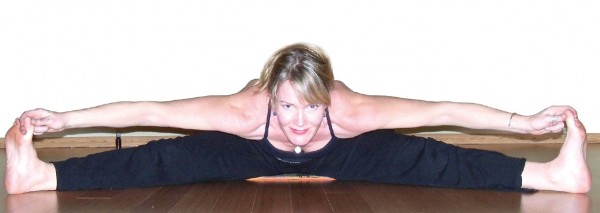 Now don’t just pass over this article because the thought of Yoga terrifies you. Perhaps you think it’s just a trend. Is yoga one of those weird cults where they chant? Maybe you have considered trying a class at the gym, but the thought of all those young girls in spandex is slightly intimidating. Perhaps because you have overly tight quadriceps from skiing your whole life, you feel there is no hope. Or maybe you just feel like you’re just too old to try something new like yoga.
Now don’t just pass over this article because the thought of Yoga terrifies you. Perhaps you think it’s just a trend. Is yoga one of those weird cults where they chant? Maybe you have considered trying a class at the gym, but the thought of all those young girls in spandex is slightly intimidating. Perhaps because you have overly tight quadriceps from skiing your whole life, you feel there is no hope. Or maybe you just feel like you’re just too old to try something new like yoga.
Well you are wrong. Yoga is for everyone. Yoga is an amazing tool that has many benefits. It can help your slope riding in so many ways such as improvement in alignment, sharpens your mindfulness and increases your range of motion. Yoga is for all ages, sizes and levels. Through yoga, you may be able to draw awareness to your limitations and move beyond. So, come join me in a little moment of bliss. I began my Yoga journey twelve years ago. Since then, I have discovered its benefits. It keeps me in shape, increases my flexibility, bolsters my strength and improves my balance. Yoga to me is the fountain of youth.
Maybe by now I’ve caught your attention and you might wonder, “How does this relate to skiing or riding?” Alignment, flexibility, balance and strength of the mind and of the body is how. Alignment is defined as the positioning of the skeletal structure to its fullest potential while maintaining muscular balance and distribution of energy. Anatomically speaking, proper skeletal alignment is something that we should all strive for. Proper alignment results in efficient movement. As instructors, we are constantly trying to achieve proper alignment with our own skiing and riding. We’re also constantly trying to improve our student’s alignment. As in skiing, proper alignment in yoga is key to efficient movement and success. In both skiing and yoga, participants continually trying to push their limitations while maintaining alignment and balance. Skiing is a sport where we tend to develop tight areas of the body. We can develop tight hip flexors due to improper alignment. To minimize knee injury it is important to maintain flexibility in the hip flexors and quadricep muscles. By keeping balance in the leg muscle strength, we increase our joint strength. By having over developed quads or hamstrings, we put ourselves at increase risk. Through the yoga poses discussed below, I hope to show you how to maintain and improve this muscular balance, thus reducing the risk of injury. Now there is a lot more to Yoga than just stretching. It also has a component of mindfulness. Mindfulness you say? What is that? Well, it’s like that perfect day, when you get to the mountain, the sun is shining and it has dumped two feet overnight. It is 20 degrees and you are not there to work. You get to the top and you hit your favorite run. You begin to feel light, happy, and aware of all your surroundings. Nothing else matters. The lists, thoughts, emotions and responsibilities all fade to nothing. You are doing what you love in that moment and that is pure joy. Yoga seeks to find that in all that we do. Allowing those thoughts to melt away and taking the time to connect to your true self.
One way we do this is through breath work. The power of the breath is amazing. It is a lot like the wind. It is always there, but maybe not seen or recognized. Taking a few moments to focus your intentions on your breath at the start of each day, or at the beginning of your yoga, can center you. We tend to create busy minds. By bringing awareness to the present moment, just like that perfect ski day, we are able to quiet the monkey mind and feel bliss or joy. Breath work can be great in an exam or tryout situation. Perhaps you are tense or feeling a lot of pressure to perform. You may be lacking focus or confidence. Try taking several deep breaths to calm your nerves and focus all your attention on your breath for several seconds. See how this helps you relax and be in the moment. This may change your tension to intention. With all your intention being focused you will be able to perform your best. Here are a few yoga stretches that any and all snow sports enthusiasts can do at home. Some of these poses are to help release tightness while others are geared towards increasing proprioceptor awareness or balance. Still, others are for strength. These can be done on a yoga mat or your carpet at home. There should never be any pain in any poses. If you experience pain, please stop and modify or move on to the next pose.
Upavishta Konasana (wide leg forward stretch – photo top)
Sit up tall on your mat and open your legs into a V. Deep breath in and exhale forward fold. You can prop your torso up using your hands or elbows. To make it harder, grab you feet on the outside edges or the big toes. This stretch helps out the hamstrings muscle group, the adductors and the low back. The low back can become very tight in skiing. Especially if our skeletal alignment is off. Hold this 3 to 4 minutes.
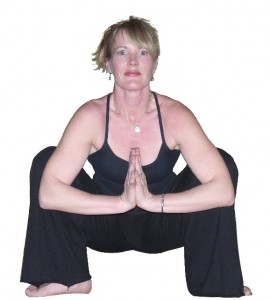 Malasana (wide leg squat – photo above)
Malasana (wide leg squat – photo above)
Try keeping your feet facing as forward as possible. You can use a blanket under the heals of the feet to modify. This helps relieve compression of the ankle joint. Draw the pelvis towards the floor and the spine towards the sky. Lift up through the crown of your head, while grounding with gravity through into the pelvis. Squats are great for men and woman. They open up the deep hip rotators and strengthen the spinal muscles. Squats can be held between 3-5 minutes.
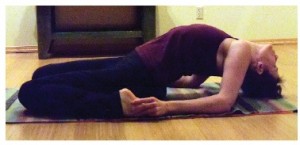 Virasana (heros posture – photo above)
Virasana (heros posture – photo above)
This pose is easy for many. Those with tight quads will find it challenging, yet rewarding. If your hips do not reach the ground, use a block or a blanket to put under the pelvis. Keep core muscles engaged! Try not to round the low back. If this is an easy pose for you, lay back in-between your feet, and rest your spine on your mat. This pose is restorative, and can be held for 5 minutes or more. Repeat 3-5 times.
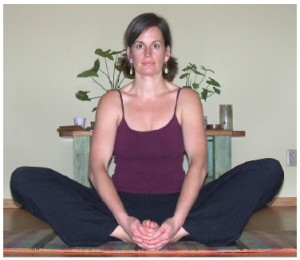 Baddha Konasana (butterfly pose – above)
Baddha Konasana (butterfly pose – above)
Gently place the soles of your feet together and let gravity pull your knees towards the floor. You may modify by placing a block under the tailbone to lift the rear pelvis off your mat a bit. To challenge yourself, take a deep breath in and exhale into a forward fold. Be sure to go only as far as you can with a straight back. This helps to release the adductor muscle group. We use the adductors in lateral movements on the snow. This pose can be held 5- 8 minutes if there is no pain in the knees.
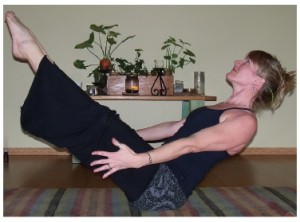 Navasana (boat pose – photo above)
Navasana (boat pose – photo above)
Balancing on your SITS bones, begin to raise up both or one legs to eye level. Your knees can be bent to modify or you can hold behind your knees with your hands to modify. For the full poses, simply create a V with body and hold for 5 breaths. Release and repeat 5 times. This pose targets your core strength. Core strength is necessary in many tasks like short radius turns, hop turns, jump entry turns and skating.
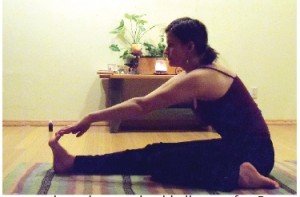 Trianga Mukhaikapada Paschimottanasana (photo above)
Trianga Mukhaikapada Paschimottanasana (photo above)
This can be done with a block or blanket under the hip with the outstretched leg. By lifting the pelvis on that side you will level it out and feel more even. Use a mat or a blanket so the foot that is turned under does not hurt by digging into the floor. The out stretched leg is lengthening the hamstrings, while the leg that is bent back get a quad stretch. Forward fold over the out stretched legs make this harder. You can reach for the forward foot to bind. The back foot should be facing straight back. Make sure to hold 3 to 4 minutes then switch sides.
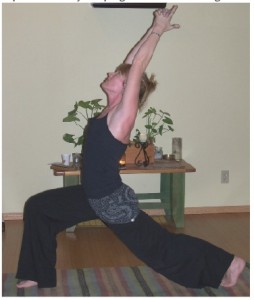 Crescent Lunge (photo above)
Crescent Lunge (photo above)
From standing, step one foot back into a lunge position. Begin by lowering your pelvis towards the ground. To increase your balance and strength, reach the arms and shoulders toward the sky. This helps to open the hip flexors of the back leg. It also helps strengthen the lumbar muscles and the front leg muscles as well.
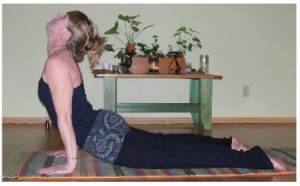 Urdva Mukha Svanasana (up dog/cobra – photo above )
Urdva Mukha Svanasana (up dog/cobra – photo above )
Come to laying flat on your belly. Begin by pressing all 10 toes into the floor. Bring the hands directly under the shoulders. Roll the shoulders up and back, and gently press your torso up. You may be able to lift off the floor completely. Or, just the chest and belly might come off. Wherever you are, breath five breathes while in the pose. Release down to your belly and repeat two more times. This pose opens the front side of the body and strengthens the lower back.
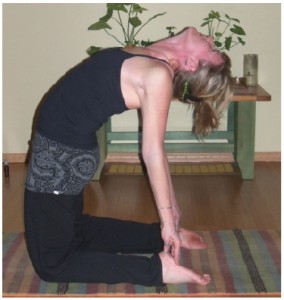 Ustrasana (camel pose – photo above)
Ustrasana (camel pose – photo above)
Begin by standing on your knees. Knees are hip distance apart. You can add extra padding under them. Begin by grounding the shins into the floor. Lift up through the heart area, and place your hands on your hips. Next, press the hips forward. Then, if you want more, reach back and grab your heels with your hands. This is a back opener. It lengthens out the core muscles in the belly and those tight hip flexors. Hold for five breaths,
repeat three times.
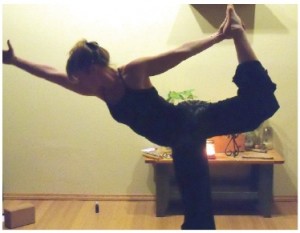 Natrajasana (dancer – photo above)
Natrajasana (dancer – photo above)
For those individuals challenged by balance, this pose can be conducted facing a wall. Stand several feet back from the wall. Find your balance on the standing leg. Root down into the standing foot and toes, as you reach back with the opposite hand and grab the opposite foot or ankle. Begin to lean forward, pushing the foot into the hand, creating a bow shape. This is a back opener and a strong balancing pose. It will help open up the quadriceps. For those using the wall, place your fingertips on the wall to aid in balance as you lean forward.
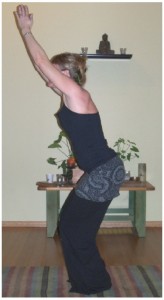 Utkatasana (chair pose – photo above)
Utkatasana (chair pose – photo above)
Come to standing at the front of your mat. Inhale. Reach your arms straight up toward the sky. Begin to pull shoulder blades down the spine while keeping arms up. Begin to sink low like you are about to sit in a chair. Tuck the tail bone under and engage your core by pulling the belly button back towards your spine. This is a difficult pose and can be repeated three times. It strengthens the lower spine and core muscle group. This pose assists in proper skiing alignment because the hips have to be over the ankles. This pose can be done at the wall, then gradually wean yourself off of it as you become stronger. Balance and stance are key components of this posture.
After you have completed the poses that feel good for you and your body, take a moment and rest on your back in total relaxation. A few minutes is enough; ten is ideal. Take this quiet time to scan your body and feel any changes. Try to let go of any tension you may be holding onto. Check in with places like your jaw and your neck. Gently begin to melt into your mat and let the thoughts that come into your mind be whisked away like the clouds in the sky. Try to be present in the moment. This is ideal for skiing because it can help calm the mind and focus the thoughts. Yoga helps to teach us to live each moment to the fullest. Yoga aids in alignment, balance, flexibility and strength. With dedication and commitment, snow sports riders of all levels can improve their abilities through yoga. All of the simple poses listed above can be performed safely at home. It is my belief that Yoga and Snowsports have a lot of lateral learning. My goal is to help educate through more body awareness. This can be a great way to start. Enjoy these poses and there may be more to come. Photography and modeling by Angeline Rhett and Tara Seymour. Photos taken at Life Love Yoga in Sisters, Oregon.

